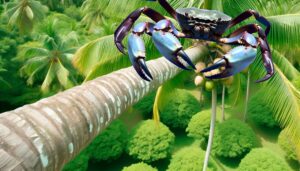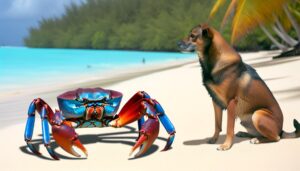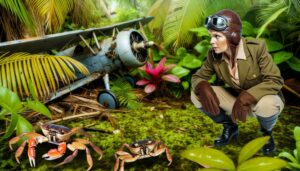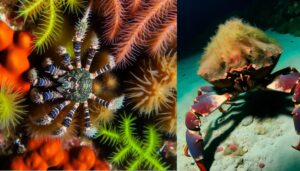How You Can Safely Hold a Fiddler Crab
Owning a coconut crab as a pet isn't simple. Legal restrictions exist due to their vulnerable status, necessitating permits.
Their habitat needs are specific; they require large enclosures with deep substrate and climbing structures, as well as a stable temperature of 75-85°F and 70-80% humidity. Diets must closely mimic the wild, including varied fruits, nuts, and animal matter.
Handling requires caution due to their powerful claws. Additionally, their complex behavioral and health needs make captive care challenging.
Those curious about the detailed requirements and considerations for keeping coconut crabs will find detailed insights ahead.
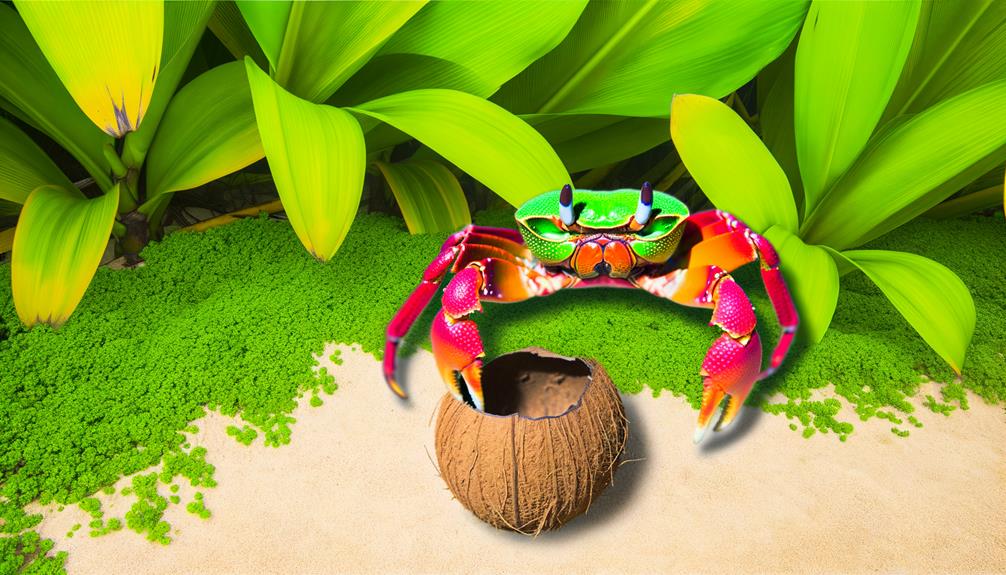
Key Takeaways
- Check local legal restrictions and obtain necessary permits to keep a coconut crab as a pet.
- Provide a spacious, secure enclosure with proper temperature and humidity control.
- Ensure a diverse diet that includes fruits, nuts, seeds, and occasional animal proteins.
- Handle with caution using protective gloves and tools to minimize stress and injury.
- Be aware of the significant ethical and environmental impacts of keeping coconut crabs in captivity.
Legal Considerations
Before acquiring a coconut crab as a pet, one must first investigate the legal restrictions and requirements in their region, as these can vary greatly by location. Many jurisdictions have stringent regulations due to the coconut crab's status as a vulnerable species. Prospective owners should consult local wildlife authorities and obtain any necessary permits or licenses.
Additionally, importation laws might restrict the transport of coconut crabs across borders. It's essential to understand the penalties for non-compliance, which can include hefty fines or confiscation of the animal. Ensuring adherence to regional laws not only protects the species but also promotes ethical stewardship.
Detailed research and thorough documentation are essential steps before proceeding with the acquisition of a coconut crab.
Habitat Requirements
To maintain a healthy coconut crab, one must address specific habitat requirements, focusing on space and enclosure needs, as well as temperature and humidity control. Coconut crabs require ample space to mimic their natural environment and prevent stress-induced behaviors.
Additionally, maintaining appropriate temperature and humidity levels is essential for their physiological well-being and molting processes.
Space and Enclosure Needs
A coconut crab requires a spacious, safe enclosure that mimics its natural habitat to guarantee its well-being and prevent escape. The enclosure should be large enough to accommodate the crab's substantial size and activity level.
Key features of an ideal habitat include:
- Robust construction: to withstand the crab's strength and climbing abilities.
- Deep substrate: for burrowing, essential for both comfort and natural behavior.
- Climbing structures: replicating trees and rocks found in their native environment.
- Secure lid: to prevent the crab from escaping, as they're excellent climbers.
Creating such an environment demands attention to detail and commitment to the crab's natural instincts and needs. Proper habitat design ensures the coconut crab can thrive in captivity, offering a closer approximation to its natural lifestyle.
Temperature and Humidity
Maintaining ideal temperature and humidity levels is essential for the health and well-being of a coconut crab, as these parameters closely resemble the tropical conditions of their natural habitat.
Best temperatures range between 75-85°F (24-29°C), requiring the use of heating elements or climate-controlled enclosures.
Humidity should be consistently kept at 70-80%, achievable through regular misting and hygrometers for monitoring.
Both temperature and humidity fluctuations can stress coconut crabs, leading to potential health issues such as desiccation or respiratory problems.
Additionally, proper ventilation is necessary to prevent mold growth, which thrives in humid environments.
Following these environmental requirements ensures a stable, conducive habitat, promoting the crab's longevity and overall well-being.
Diet and Nutrition
Coconut crabs require a diet rich in proteins, fats, and essential minerals to maintain their health. In their natural habitat, they consume a variety of food sources, including fruits, nuts, and carrion.
Pet owners must replicate this dietary diversity to guarantee the crab's nutritional needs are met.
Natural Food Sources
In the wild, coconut crabs primarily forage for a diverse range of foods including fruits, nuts, seeds, and even small animals. This guarantees they receive a balanced diet rich in essential nutrients, which is important for maintaining their health and longevity. They've been observed climbing trees to access coconuts and employing their powerful claws to crack open the hard shells. Additionally, they scavenge on carrion, providing them with necessary proteins.
The varied diet includes:
- Fruits: Mangoes, guavas, and bananas.
- Nuts and Seeds: Coconuts, almonds, and other tropical nuts.
- Animal Matter: Small birds, rodents, and carrion.
- Leaf Litter: Decaying plant material and fallen leaves.
Understanding their natural food sources is essential for replicating their diet in captivity.
Nutritional Requirements
Ensuring a coconut crab's diet in captivity meets its nutritional requirements involves carefully replicating the variety and balance of its natural food sources. Coconut crabs are omnivores, consuming a mix of fruits, nuts, seeds, and animal matter.
In captivity, their diet should include coconut, their namesake food, alongside other tropical fruits like papaya and mango. Nuts such as almonds and walnuts are essential for their protein intake. Additionally, occasional animal proteins—like cooked chicken or fish—are necessary to mimic their natural scavenging habits.
Supplements of calcium are also critical for maintaining their exoskeleton health. Without a well-rounded diet, coconut crabs may suffer from nutritional deficiencies, leading to poor health and reduced lifespan.
Careful dietary planning is imperative for their well-being.
Lifespan and Growth
Over the span of several decades, coconut crabs exhibit significant growth, with some individuals living up to 60 years under best conditions. These terrestrial crustaceans undergo a series of molts, each contributing to their increasing size and robustness. Growth rates vary based on environmental factors, diet, and availability of resources.
Factors influencing growth and lifespan:
- Molting Frequency: Young crabs molt more frequently, leading to faster growth.
- Diet: Nutrient-rich diets enhance growth and longevity.
- Habitat: Access to ideal living conditions prevents stress and promotes health.
- Genetics: Genetic makeup can dictate potential size and lifespan.
Understanding these factors is essential for anyone considering keeping a coconut crab as a pet, ensuring the creature's well-being and longevity.
Handling and Interaction
When handling a coconut crab, one must prioritize safety precautions due to their powerful claws that can cause injury.
It's essential to minimize physical contact to reduce stress on the crab and prevent potential harm.
Understanding the crab's behavior, such as their nocturnal activity and territorial nature, is vital for safe and effective interaction.
Safety Precautions First
Handling a coconut crab requires strict adherence to safety protocols due to their powerful claws and potential to inflict serious injury. When interacting with these creatures, one must implement thorough safety measures to guarantee both human and animal welfare.
Specific precautions include:
- Wearing thick, protective gloves: This minimizes the risk of claw-related injuries.
- Using proper handling tools: Such as tongs or crab traps to avoid direct contact.
- Staying calm and composed: Sudden movements can startle the crab, increasing the risk of aggression.
- Securing the environment: Ensuring the enclosure is escape-proof to prevent unsupervised encounters.
Minimize Physical Contact
Minimizing physical contact with a coconut crab is crucial to mitigate stress and decrease the risk of injury to both the handler and the animal. Coconut crabs possess strong claws capable of exerting significant force, making handling potentially hazardous. They're also highly sensitive to stress, which can affect their health and well-being.
To interact safely, handlers should use tools like tongs or gloves specifically tailored for crustaceans. Additionally, maintaining a calm environment and avoiding sudden movements can help reduce the crab's stress levels. Observing the crab from a distance and limiting direct interaction guarantees a safer experience for both parties.
Properly designed enclosures with hiding spots can also help sustain a low-stress environment for the crab.
Understanding Crab Behavior
Understanding coconut crab behavior is essential for ensuring safe and effective handling and interaction. These crabs exhibit unique behaviors that need careful consideration. Coconut crabs are territorial and can become aggressive if they feel threatened.
They're also nocturnal, meaning they're most active at night. Their powerful claws can cause injury if not handled properly.
- Territoriality: They defend their space aggressively.
- Nocturnality: Most active during nighttime, requiring nighttime observation.
- Powerful Claws: Capable of exerting significant force, necessitating cautious handling.
- Curiosity: They explore their environment extensively, indicating a need for secure enclosures.
Recognizing these behaviors helps in creating a safe environment for both the crab and its handler. This understanding is key to a positive interaction with these fascinating creatures.
Health and Veterinary Care
Ensuring the health and well-being of a coconut crab involves regular veterinary check-ups to monitor for potential illnesses and nutritional deficiencies. Coconut crabs are susceptible to shell rot, parasitic infections, and metabolic bone disease. Proper diet, consisting of calcium-rich foods, is vital. Regular observation for abnormal behavior or physical changes can preempt severe health issues.
| Common Conditions | Symptoms | Treatment |
|---|---|---|
| Shell Rot | Discolored or soft shell | Antibiotic treatment |
| Parasitic Infections | Lethargy, weight loss | Deworming medication |
| Metabolic Bone Disease | Weak limbs, soft exoskeleton | Calcium supplementation |
| Dehydration | Lethargy, sunken eyes | Increased humidity |
| Nutritional Deficiency | Slow growth, poor molting | Balanced diet |
Providing a stable environment with proper humidity and temperature is crucial for their health.
Cost of Ownership
Owning a coconut crab entails various costs, including initial purchase, habitat setup, ongoing maintenance, and potential veterinary expenses. The initial purchase of a coconut crab can range from $50 to $200, depending on the size and rarity.
Habitat setup requires a large terrarium, substrate, heating elements, and climbing structures, which can total between $100 and $300. Ongoing maintenance costs aren't negligible, primarily including food, such as fruits, nuts, and specialized crab feed, and periodic substrate replacement. Veterinary expenses can be unpredictable but should be budgeted for potential health issues.
A detailed financial plan is essential for potential owners.
Environmental Impact
Potential owners should also consider the environmental impact of keeping a coconut crab in captivity. This involves the sustainability of sourcing these crabs and the ecological consequences of removing them from their natural habitat. Coconut crabs play a vital role in their ecosystems by aiding in seed dispersal and nutrient cycling. Over-collection can lead to population declines, destabilizing local ecosystems.
Moreover, the transport of coconut crabs across regions can introduce invasive species or diseases, negatively impacting native wildlife. Sustainable practices, such as regulated breeding programs, could mitigate some of these concerns. Hence, the potential ecological ramifications of coconut crab captivity necessitate thorough assessment to guarantee both the species and their habitats remain preserved and balanced.
Ethical Concerns
Keeping coconut crabs as pets raises ethical concerns due to the potential stress and harm inflicted on the animals during capture, transport, and captivity. These creatures are often removed from their natural habitats, which disrupts their ecological roles and affects biodiversity. Additionally, the following points highlight the ethical dilemmas:
- Capture Methods: Techniques used to capture coconut crabs can be invasive and harmful.
- Transport Conditions: Inadequate transport conditions can lead to injury or death.
- Behavioral Needs: Captivity often fails to meet the complex behavioral needs of coconut crabs.
- Lifespan and Health: Lifespan can be significantly reduced in captivity due to inadequate care.
Understanding these factors is essential for making informed decisions about keeping coconut crabs as pets.
Space and Enclosure
To properly house a coconut crab, one must provide a spacious and safe enclosure that mimics its natural habitat as closely as possible. The enclosure should measure at least 6 feet by 6 feet to accommodate the crab's need for space.
It must include a substrate of sand and soil, at least 12 inches deep, for burrowing. The temperature should be maintained between 75-85°F, with humidity levels around 70-80%. Safe lids are essential since coconut crabs are excellent climbers.
Additionally, the enclosure should provide hiding spots, branches for climbing, and freshwater and saltwater sources. This setup guarantees the crab's physical well-being and supports its natural behaviors, reducing stress and promoting overall health.
Social Needs
Understanding the social needs of coconut crabs is important for ensuring their psychological well-being in captivity. Coconut crabs, or Birgus latro, are generally solitary creatures. However, understanding their social dynamics can help in creating a suitable environment.
Key considerations for their social needs include:
- Territoriality: They require ample space to establish their territories, reducing stress and aggression.
- Interaction: Limited, structured interaction with other crabs can be beneficial, provided the enclosure is spacious enough.
- Enrichment: Providing objects for exploration and manipulation can simulate natural behaviors and reduce boredom.
- Observation: Regular monitoring of behavior is essential to detect signs of stress or conflict early.
Addressing these factors can greatly improve the quality of life for coconut crabs in captivity.
Potential Risks
Coconut crabs present several potential risks in captivity, including their powerful claws, which can cause serious injuries to handlers and damage to their enclosures. These crustaceans possess pincers capable of exerting force up to 742 Newtons, making them a substantial hazard. They can easily break plastic and even thin metal, necessitating robust, reinforced housing.
Moreover, coconut crabs have a propensity to escape, which can lead to them becoming invasive species in non-native environments. Their nocturnal nature means they're often active when humans are not, increasing the likelihood of unnoticed damage or escape attempts.
Additionally, their dietary needs require careful handling, as improper feeding can lead to health issues, both for the crabs and any other pets in proximity.
Alternative Pets
Given the substantial risks associated with keeping coconut crabs, exploring alternative pets that offer both safety and enrichment is prudent.
Many small pets are suitable for domestic environments, providing companionship and requiring manageable care. Consider the following options:
- Hermit Crabs: Easier to maintain and less hazardous, these crabs thrive in simple habitats.
- Geckos: Known for their docile nature, geckos are low-maintenance reptiles that adapt well to captivity.
- Hamsters: These small rodents are popular for their playful behavior and straightforward care requirements.
- Betta Fish: Vibrant and relatively low-maintenance, betta fish are ideal for those interested in aquatic pets.
Each alternative offers a unique set of benefits, ensuring safety and satisfaction for both pet and owner.
Conclusion
To sum up, keeping a coconut crab as a pet is a complex endeavor requiring meticulous attention to legalities, habitat, diet, and social needs. These creatures grow notably and need ample space, making them less practical for most pet enthusiasts.
Handling them poses potential risks due to their powerful claws. Instead of chasing this wild goose, consider alternative pets that are easier to care for and more suited to a domestic environment.

